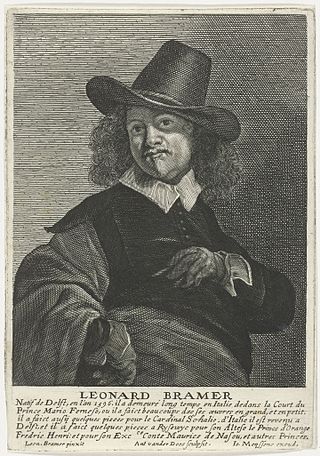
Aelbert Jacobszoon Cuyp was one of the leading Dutch Golden Age painters, producing mainly landscapes. The most famous of a family of painters, the pupil of his father, Jacob Gerritszoon Cuyp (1594–1651/52), he is especially known for his large views of Dutch riverside scenes in a golden early morning or late afternoon light. He was born and died in Dordrecht.

Hendrick Avercamp was a Dutch painter during the Dutch Golden Age of painting. He was one of the earliest landscape painters of the 17th-century Dutch school, he specialized in painting the Netherlands in winter. His paintings are colorful and lively, with carefully crafted images of the people in the landscape. His works give a vivid depiction of sport and leisure in the Netherlands in the beginning of the 17th century. Many of Avercamp's paintings feature people ice skating on frozen lakes.

Johannes Vermeer was a Dutch Baroque Period painter who specialized in domestic interior scenes of middle-class life. He is considered one of the greatest painters of the Dutch Golden Age along with Rembrandt. During his lifetime, he was a moderately successful provincial genre painter, recognized in Delft and The Hague. He produced relatively few paintings, primarily earning his living as an art dealer. He was not wealthy at his death, leaving his wife in debt.

Paulus Potter was a Dutch painter who specialized in animals within landscapes, usually with a low vantage point.

Jacob Isaackszoon van Ruisdael was a Dutch painter, draughtsman, and etcher. He is generally considered the pre-eminent landscape painter of the Dutch Golden Age, a period of great wealth and cultural achievement when Dutch painting became highly popular.

Abraham Bloemaert was a Dutch painter and printmaker who used etching and engraving. He initially worked in the style of the "Haarlem Mannerists", but by the beginning of the 17th-century altered his style in line with the new Baroque style that was then developing. He mostly painted history subjects and some landscapes. He was an important teacher, who trained most of the Utrecht Caravaggisti.

Adriaen van de Velde, was a Dutch painter, draughtsman and print artist. His favorite subjects were landscapes with animals and genre scenes. He also painted beaches, dunes, forests, winter scenes, portraits in landscapes, as well as mythological and biblical scenes. He belongs to a group of painters referred to as the Dutch Italianate painters, who combined Dutch agricultural landscapes with mythological or Arcadian scenes in Italian settings. His paintings are characterised by their delicate, careful composition and his mastery of lighting effects as well as the human figure.

Anthonij "Anton" Rudolf Mauve was a Dutch realist painter who was a leading member of the Hague School. He signed his paintings 'A. Mauve' or with a monogrammed 'A.M.'. A master colorist, he was a very significant early influence on his cousin-in-law Vincent van Gogh.

The Hague School is a group of artists who lived and worked in The Hague between 1860 and 1890. Their work was heavily influenced by the realist painters of the French Barbizon school. The painters of the Hague school generally made use of relatively somber colors, which is why the Hague School is sometimes called the Gray School.

Bartholomeus van der Helst was a Dutch painter. Considered to be one of the leading portrait painters of the Dutch Golden Age, his elegant portraits gained him the patronage of Amsterdam's elite as well as the Stadtholder's circle. Besides portraits, van der Helst painted a few genre pictures as well as some biblical scenes and mythological subjects.

Michiel Janszoon van Mierevelt, often abbreviated as Michiel Jansz. and the surname also spelled Miereveld or Miereveldt, was a Dutch painter and draftsman of the Dutch Golden Age.

Jan Mostaert was a Dutch Renaissance painter who is known mainly for his religious subjects and portraits. One of his most famous creations was the Landscape with an Episode from the Conquest of America.

Aert de Gelder was a Dutch painter. He was the only Dutch artist to paint in the tradition of Rembrandt's late style into the 18th century.

Jacob Adriaensz Backer was a Dutch Golden Age painter. He produced about 140 paintings in twenty years, including portraits, religious subjects, and mythological paintings. In his style, he was influenced by Wybrand de Geest, Rubens and Abraham Bloemaert. He is also noted for his drawings of male and female nudes.

Leonaert Bramer, also Leendert or Leonard, was a Dutch painter known primarily for genre, religious, and history paintings. Very prolific as a painter and draftsman, he is noted especially for nocturnal scenes which show a penchant for exotic details of costume and setting. He also painted frescos—a rarity north of the Alps—which have not survived, as well as murals on canvas, few of which are extant. Bramer is one of the most intriguing personalities in seventeenth-century Dutch art.

Paulus Moreelse was a Dutch painter, mainly of portraits.

Wallerant Vaillant was a painter of the Dutch Golden Age and one of the first artists to use the mezzotint technique, which he probably helped to develop.

Roelof Jansz van Vries or Roelof van Vries is a dutch painter of the Dutch Golden Age. Known for his landscapes, his works can be seen at the Metropolitan Museum of Art, the Rijksmuseum, the National Gallery, etc.

Jan Gildemeester Jansz. was a Dutch art collector.

The Art Gallery of Jan Gildemeester Jansz is a painting created by the Dutch painter Adriaan de Lelie in 1794–95. It is part of the collection of the Rijksmuseum Amsterdam, executed in oil paint on panel. It depicts the art collector Jan Gildemeester Jansz in the midst of his large collection of paintings, showing them to friends.
























